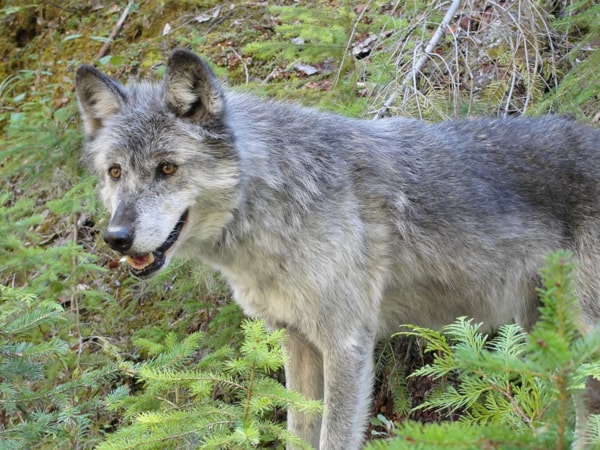Want to be a National Geographic photographer? I do! Unfortunately, the quality of my pictures will not get me on the payroll anytime soon.
However, I felt like a real wildlife shutterbug when I took a photography tour at the Northern Lights Wildlife Wolf Centre near Golden, B.C.
The centre is the only place in the world where a person can walk in the wilderness with a full-blood wolf off-leash.
For $295, one or two people can take their camera, big or small, for a 90-minute hike with a wolf.
My visit started with an orientation by Dave Whyte, an interpreter who explained the sorry state of wolves in the Canadian Rockies. “In the wild, wolves have, on average, a lifespan of four years.”
Wolves may be popular on greeting cards and T-shirts, but not among ranchers and hunters.
Although they are an important predator in mountain ecosystems, they are not protected when they leave national parks and many die from road accidents, poisoning or hunting.
The Northern Lights Wildlife Wolf Centre aims to change public perception.
Originally, Casey Black wanted to train wolves for movies, but founded the centre when he realized wolves were poorly understood.
“Directors wanted to portray the wolves in movies as mean, snarling creatures,” Casey said, “and that isn’t their true nature.”
As I learned on my walk, wolves are very shy and secretive creatures. Casey explained, “If dogs were people, they would be the life-of-the-party types, while wolves would the quiet, aloof ones.”
On each photography walk, a different wolf is taken out and timing is critical. Take a wolf out too soon after it has eaten and it lies down.
Photography is easier, but not very exciting. Wait until the wolf is too hungry and they may run away on the walk. So Casey and Shelley carefully chose which wolves are ready to hike and then introduce them to their human companions.
I hiked with Maya, a 12-year old female. Light grey in colour and slight-of-build, she had a natural grace and an ephemeral beauty; she faded in and out of the forest easily.
I felt observed, not stalked, as she bounded into the trees and waited for us to catch up.
Casey brought food rewards for Maya when she responded to his calls but remembering how hard my beagle was to control, I wondered if food was enough to keep wolves from running away.
He explained, “We get the wolves from other wildlife centers when they are very young and we imprint them on us.” Casey and his wife, Shelley, are regarded as the pack’s alpha male and female, and the wolves take their cues from them.
To make sure we did not give the wolves any miscues, we got a crash course in wolf etiquette before the walk. I learned not to squat near a wolf in case they think I was acting aggressively. Unfortunately, there were no rules against taking bad photos and I took many.
Although we were close to the animals, my point-and-shoot camera didn’t respond as fast as the wolves. I deleted many headless or blurred wolf shots, but kept enough pictures to redeem myself on Facebook!
Golden isn’t the only place where people watch wolves.
They were reintroduced to Yellowstone National Park over 15 years ago and have proven to be a popular tourism draw. More that 150,000 people visit the park each year specifically for the wolves, bringing in $35 million in tourism revenues. I can understand why travellers seek out these fascinating creatures.
After spending a few hours with Maya, her gentle nature and grace made an impression that lingered long after I left the mountains. I find myself looking in the woods for a dark pair of eyes steadily watching me. Today, the eyes looking back belong to squirrels but one day soon, I’m going back where the wolves are.
Carol Patterson of Kalahari Management Inc. has been speaking and writing about nature tourism and emerging destinations for two decades. When she isn’t travelling for work, she is travelling for fun. More of Carol’s adventures can be found at www.kalahari-online.com.
